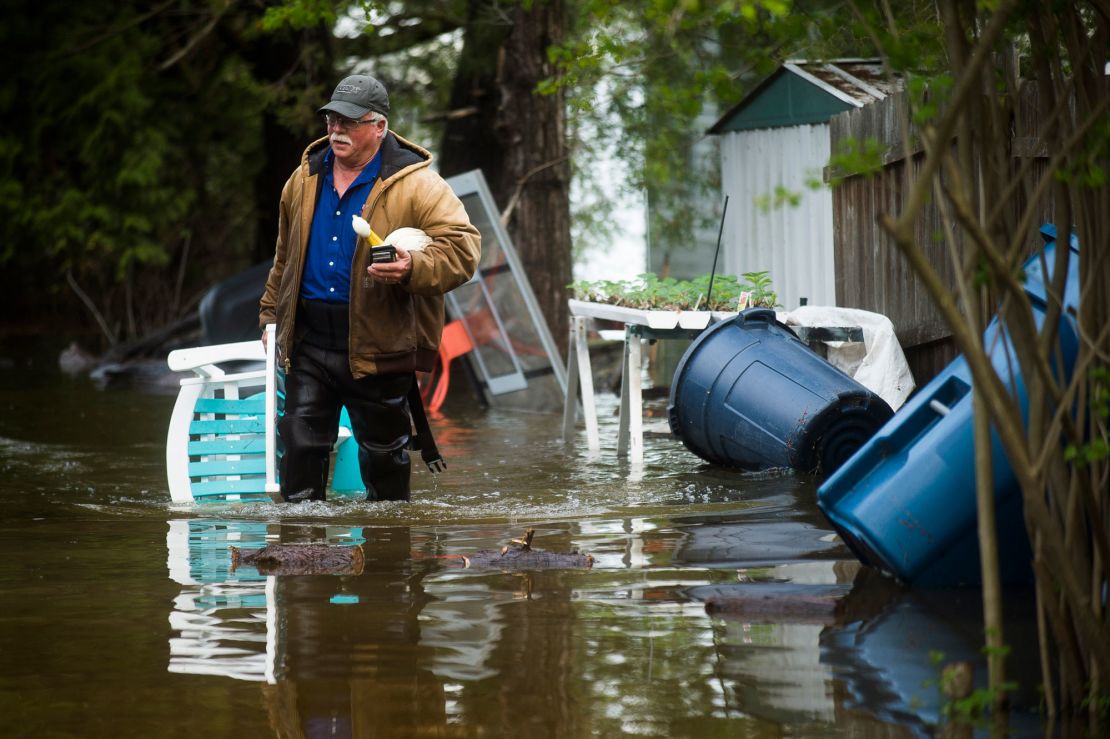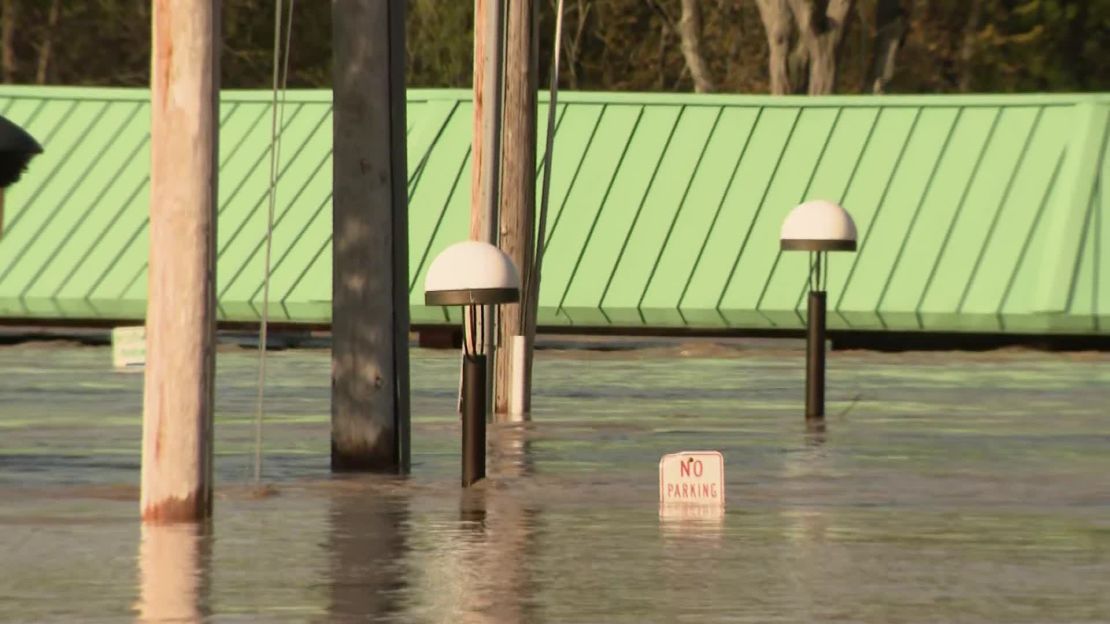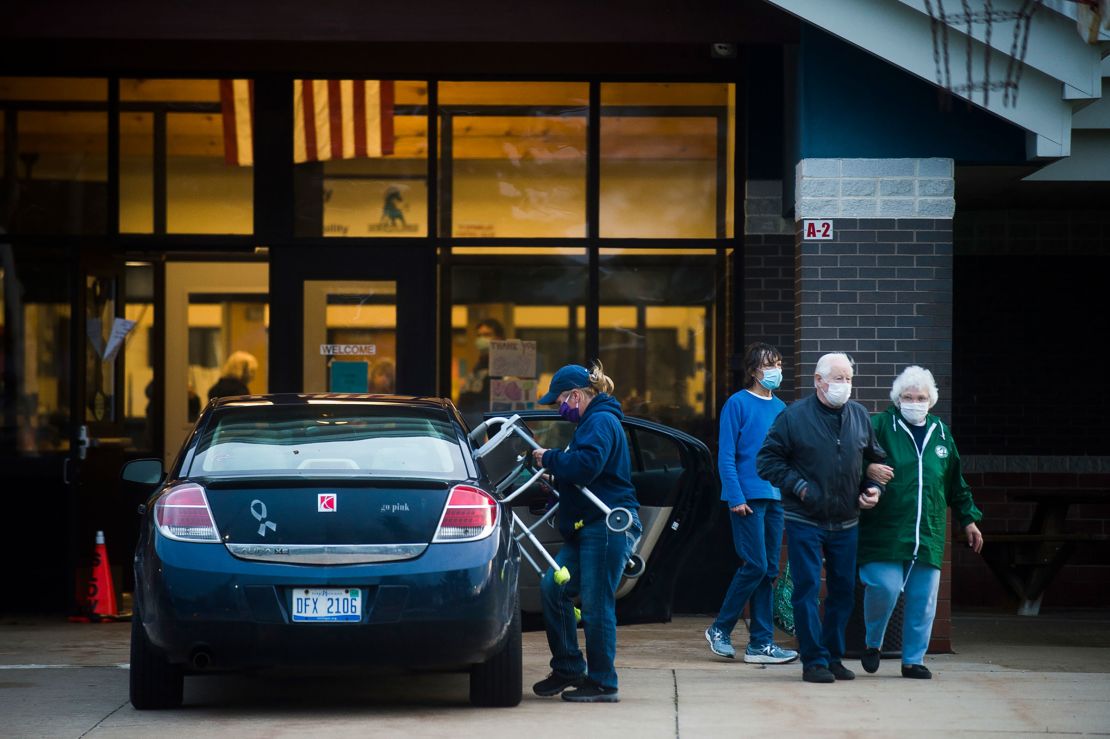The rain-swollen river that breached two dams in central Michigan crested several feet lower than expected, but authorities warned the disaster is not over yet.
“This came out quickly but it’s not going away quickly,” Brad Kaye, Midland city manager, told reporters on Wednesday night.
At least 10,000 people fled their homes in Midland and along the Tittabawassee River after two dams failed, leading to a historic flooding.
On Wednesday afternoon, the river appeared to have crested at 35.05 feet, below the 38 feet that had been projected. Hours later, floodwater appeared to be receding in some areas, Kaye said, but evacuees likely won’t return home for several days.
“It’s essentially a mess out there and it isn’t safe to drive around barriers or travel on the roads that are deemed closed,” he said.
While the full physical damage in Midland – a city of about 41,000 people downstream of the dams – is still unclear, Gov. Gretchen Whitmer described the flooding earlier on Wednesday as devastating.
Dow Chemical Co. says no ‘threat to residents or environmental damage’
Midland is home to Dow Chemical Co.’s headquarters and manufacturing complex. The company said Wednesday its facilities were safely shut down, except for those needed to manage chemical containment.
After floodwaters were mixing with a containment pond, the company and the US Coast Guard activated emergency plans, Dow said in a statement. The pond is used for storm water and brine system and groundwater remediation, it said.
“The material from the pond commingling with the flood waters does not create any threat to residents or environmental damage. There has been no reported product releases,” Dow said.
No employees were injured, the company added.
Allen Burton, a professor of environment and sustainability at the University of Michigan, said the magnitude of water will set back the cleanup of a federal Superfund site downriver caused by Dow’s release of dioxins decades ago.
Whitmer said the state will be investigating the operators of the Edenville and Sanford dams – which normally contain the Tittabawassee River to create two separate lakes.
“This incredible damage requires that we hold people responsible and we are going to pursue every line of legal recourse that we have,” Whitmer said.
10,000 people were evacuated
Water breached the two dams north of Midland on Tuesday evening after days of heavy rain.
By Wednesday morning, water – waist-deep in places near Sanford, video from CNN affiliate WDIV shows – was lapping up against businesses and homes around the county.
Evacuation orders are in effect for about 3,500 homes and 10,000 people, Mark Bone, chairman of the Midland County Board of Commissioners, said he believes.
In Midland, about 150 residents of the Riverside Place senior residence – many with walkers or riding in wheelchairs – were among those who evacuated, CNN affiliate WJRT reported.

The scene wasn’t easy to watch, said Toni Mclennan, a maintenance technician who checked the complex to make sure everyone was out.
Mclennan felt “sadness” and “the hope that they come back,” she told the station. “I mean, especially with this pandemic and you’re getting people in close quarters, it’s probably that much more scary.”
With the coronavirus pandemic months underway, officials in the county are juggling two public safety crises at once. The flood disaster is one of the first to test how local, state and federal response efforts can handle the dual challenge.
At least five shelters are running in the Midland area – at schools and family centers – and flood evacuees are being screened for the illness, officials say.

The governor declared an emergency for the flooding, and said previous orders relating to the coronavirus crisis are locally suspended if they impede emergency responses for the flooding.
Though Wednesday is sunny and rain is not expected to resume for days, the river still was rising in Midland – and by Wednesday morning was already past the previous record of 33.89 feet. That was set during a major flood in the city in 1986.
At that height alone, the river will be flooding many homes, the National Weather Service said.
The weather service previously said the river could crest at 38 feet Wednesday evening but Michigan county officials said the river had crested at 35.05 feet.
Officials are giving health screenings and distributing masks at shelters
No deaths or injuries have been reported, said Midland spokeswoman Selina Crosby Tisdale.
At the shelters, workers are checking evacuees’ temperatures and handing out masks to them because of the pandemic, Tisdale said.
Workers also are trying to space out the evacuees throughout the shelters, hoping to reduce the chances that anyone who might be carrying the virus spreads it to others.
Evacuees should expect to stay away from their homes for days, Tisdale said.”We’re still waiting to crest, and then we have to wait for water levels to recede. It’s going to take days until we get to that point.”
About 100 Michigan National Guard members are helping with evacuations, Capt. Andrew Layton said.

Police tell residents to flee over loudspeakers
Midland resident Jamie Broderick evacuated from her home overnight with family and guests after a harrowing warning.
By 11 p.m. Tuesday, with no evacuation ordered for her area, Broderick’s family of five was hosting her parents and some friends, who were in an evacuation zone. Then, sitting on a couch, she thought she heard “evacuation” from a police vehicle’s loudspeaker outside.
“It was very surreal, like out of a movie,” she said.
She ran outside barefoot and tried to flag them down. She missed them, but a friend five doors down called and confirmed what she heard: They said to evacuate.
Broderick caught up with the police car. A state trooper told her people in that neighborhood needed to leave. Though the Sanford Dam was breached, it was largely intact. But if it fell away completely, her neighborhood could be deluged, the trooper said.
The mother of three boys rushed back home and got everyone moving. After packing some essentials – clothes, food, and toys and diapers – they all drove two hours west to her parents’ lake house, where they were awaiting word of their homes Wednesday morning.
Broderick, a real estate agent, said many people in Midland don’t have flood insurance, because though the river flows through it, the city is generally far from the lakes.
“People don’t have the financial capacity to rebuild” if the city gets flooded badly, she said. “I imagine many families would have to move out.”
CNN’s Elizabeth Joseph, Rob Frehse, Michelle Krupa, Phil Gast, Kristina Sgueglia, Ganesh Setty and Joe Sutton contributed to this report.






















